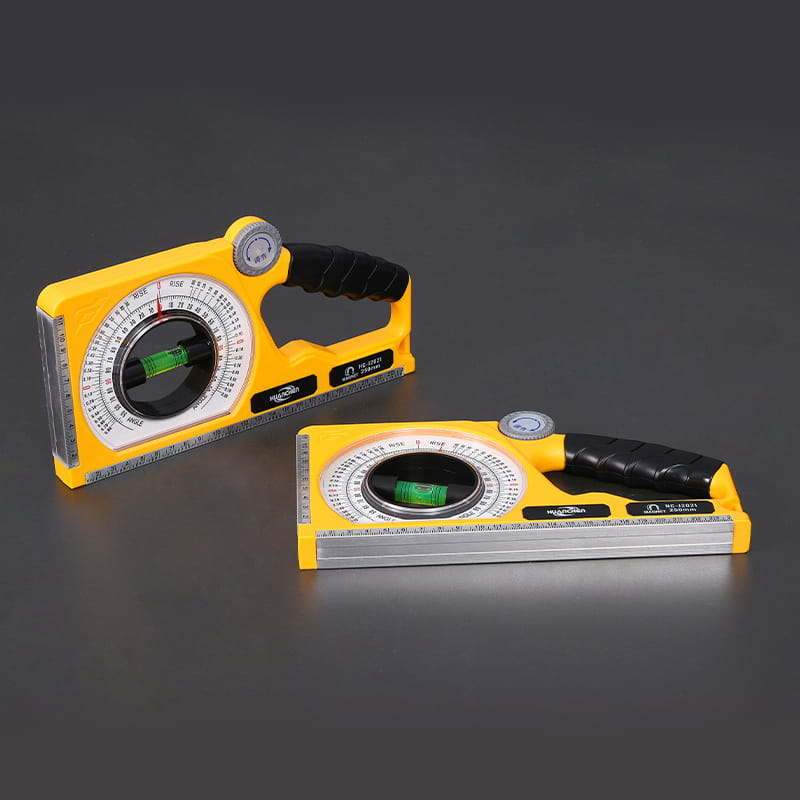●Plastic spraying surface treatment ●Wall thickness 0.8 mm ●Better surface gloss and stronger ●180° 90° 45° 3 angles blisters ●High light transmittance, high definition level bubble ●Bottom with an in...
See DetailsBasic Concepts and Application Background of Slope Measuring Rulers
A slope measuring ruler is a measuring tool used to measure slope angles or inclinations. It is widely used in various fields, including construction, road construction, water conservancy projects, landscape design, and drainage pipe laying. Its primary function is to help construction workers or designers determine whether the ground, terrain, and slope angles meet design standards, thereby ensuring construction quality and safety. Due to its complex and diverse application environments, the material and durability of a slope measuring ruler are crucial factors in determining its reliability and service life.
Common Slope Measuring Ruler Material Types
Slope measuring rulers are available in a wide variety of materials, varying in weight, accuracy, durability, and cost. Common materials include aluminum alloy, stainless steel, ABS plastic, engineering plastics, and carbon fiber. The following table compares several common materials:
Common Materials of Slope Measuring Rulers and Their Characteristics
| Material | Characteristics | Applicable Scenarios |
|---|---|---|
| Aluminum Alloy | Lightweight, corrosion-resistant, strong structural stability | Construction engineering, decoration design |
| ABS Plastic | High strength, good wear resistance, relatively light weight | Indoor use, teaching demonstration |
| Stainless Steel | Resistant to acid and alkali corrosion, durable, high hardness | Industrial measurement, laboratory environments |
| Carbon Fiber | Extremely lightweight, high strength, fatigue resistant | Precision manufacturing, aerospace industry |
| PVC | Affordable, moisture-resistant, moderate strength | Daily household use, temporary measurement tasks |
Analysis of the Usage Characteristics and Durability of Aluminum Alloy
Aluminum alloy is currently the most widely used material for slope measuring rulers. Its moderate weight makes it easy to carry and operate, and its excellent oxidation resistance allows for long-term use in a variety of environments. Aluminum alloy is inherently highly resistant to bending and resists deformation even with frequent use or minor impacts. For construction workers working in the field for extended periods, aluminum alloy rulers offer a more stable experience. Furthermore, aluminum alloy surfaces are often anodized to further enhance corrosion resistance, extending their lifespan.
Advantages and Limitations of Stainless Steel
Stainless steel slope rulers, due to their superior corrosion resistance, are often used in humid, rainy, and chemically exposed environments, such as water conservancy projects or in areas exposed to long-term outdoor exposure. Stainless steel also offers excellent scratch resistance, making the scale less susceptible to wear even with prolonged use. However, stainless steel is relatively heavy, making it unsuitable for applications requiring frequent movement. Furthermore, the high processing cost contributes to the generally higher price of this type of ruler, which can be a challenge for projects with limited budgets.

Applications of ABS Plastic and Engineering Plastics
ABS plastic slope rulers are lightweight, affordable, and easy to use, making them suitable for lightweight tasks such as home renovations and checking the slope of small water pipes. However, ABS plastic has relatively poor aging resistance and is prone to brittleness and deformation under exposure to sunlight or high temperatures. Engineering plastics such as PA and PC offer improved heat and impact resistance, making them suitable for more demanding construction conditions. However, compared to metal, their accuracy retention and deformation resistance are still slightly inferior, making them more suitable for short-term or less frequent use.
Carbon Fiber Performance in High-End Applications
Carbon fiber is a recently emerging high-performance material, boasting lightweight, high strength, and fatigue resistance. Carbon fiber grade gauges are increasingly being adopted for high-precision measurements or operations requiring extreme portability. Despite their high manufacturing cost and complex processing, the lightness and stability offered by carbon fiber are highly attractive to engineers and technicians who need to carry a large amount of measuring equipment. These products are often used in high-end architectural design, scientific research, and engineering monitoring projects.
Factors for Evaluating the Durability of Grade Gauges
The durability of grade gauges depends not only on the material but also on a variety of factors, including their structural design, manufacturing process, scale printing, and the quality of their interface components. For example, products with laser scales are less susceptible to wear than conventional printed scales. Whether or not reinforcement ribs are incorporated into the structure also affects the ruler's bending resistance. Furthermore, the presence of a protective case, dust-proof gaskets, and waterproof features can also extend the overall lifespan. The following table lists the main factors affecting the durability of a slope ruler:
Durability Performance of Slope Measuring Ruler Materials
| Material | Water Resistance | Corrosion Resistance | Impact Resistance | Service Life Expectancy |
|---|---|---|---|---|
| Aluminum Alloy | Strong | Strong | Good | 5–10 years |
| ABS Plastic | Good | Medium | Moderate | 3–5 years |
| Stainless Steel | Strong | Strong | Strong | 8–15 years |
| Carbon Fiber | Moderate | Good | Strong | 6–12 years |
| PVC | Moderate | Weak | General | 2–4 years |
Practical Tips for Choosing a Slope Ruler
When choosing a slope ruler, consider a variety of factors, including frequency of use, environmental conditions, accuracy requirements, and budget. For example, for long-term outdoor use, aluminum alloy or stainless steel is recommended. For simple household plumbing installations, plastic is generally sufficient. Users with extremely high measurement accuracy requirements or seeking lightweight operation may consider carbon fiber.